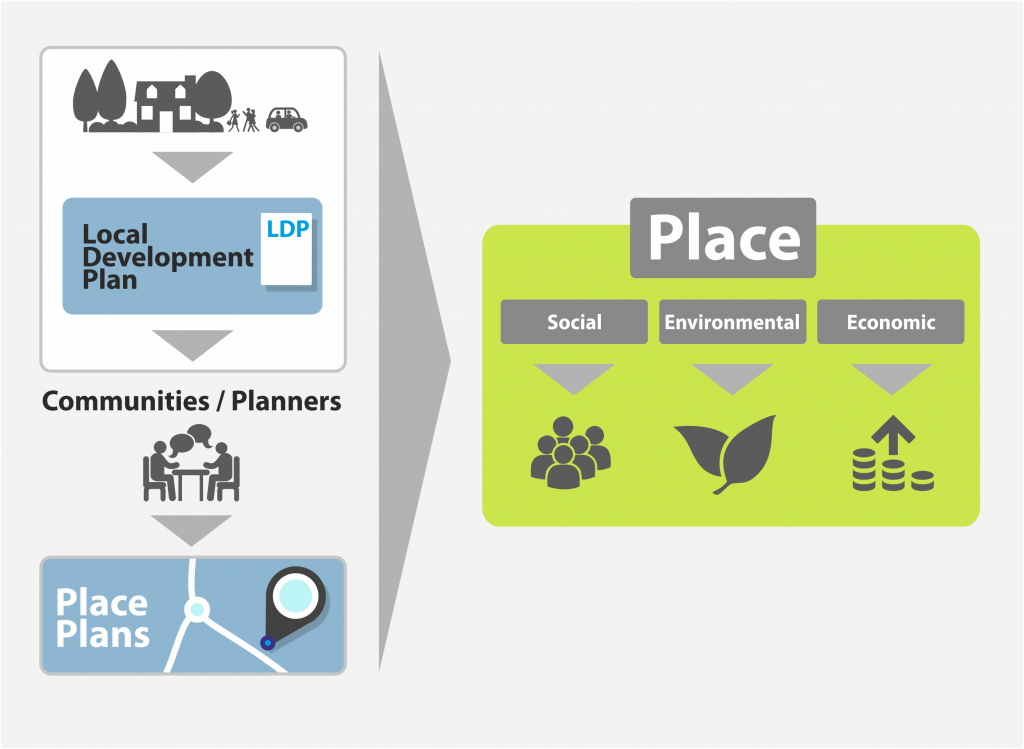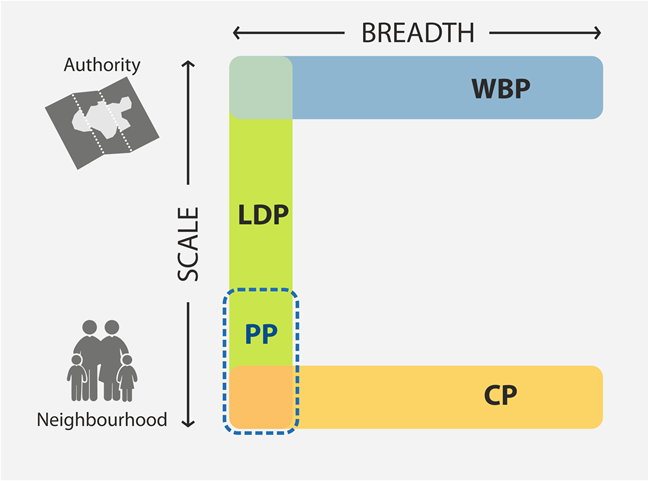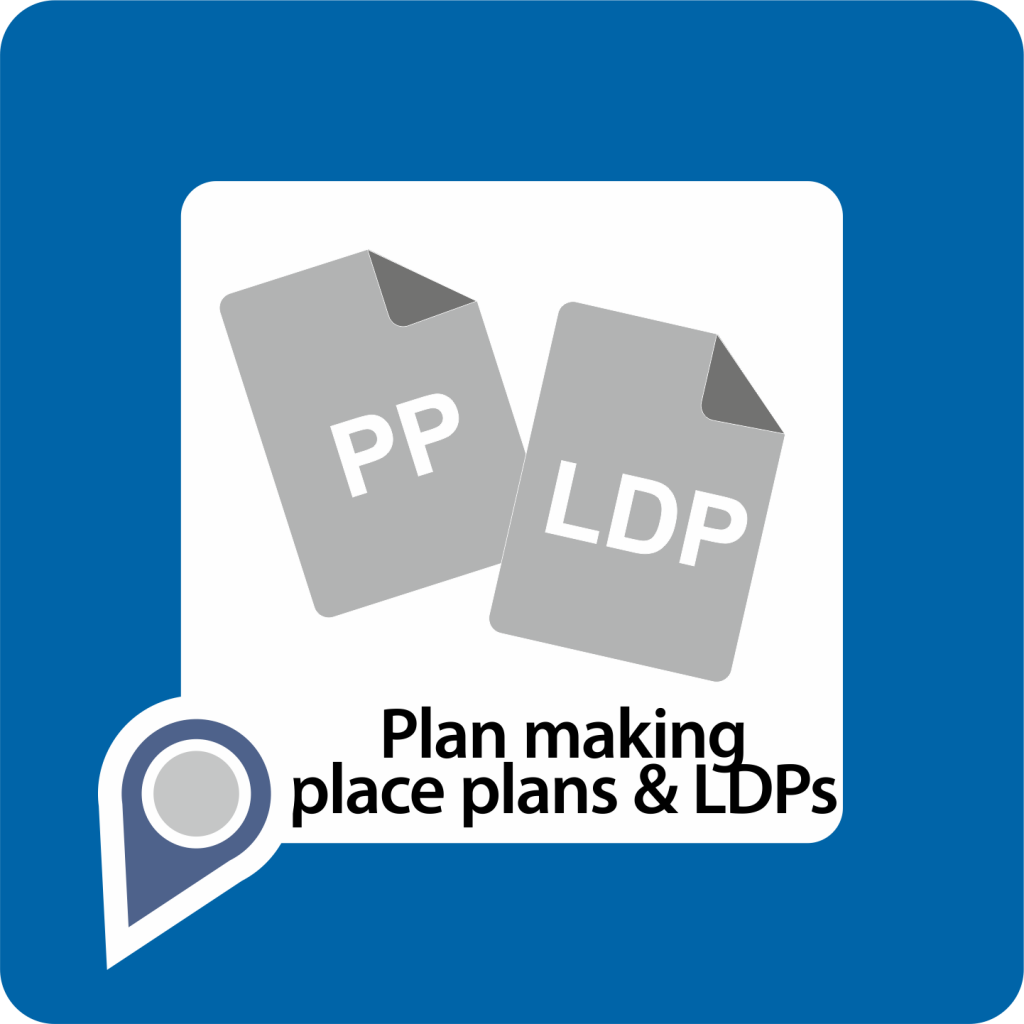Background
Place Plans are a mechanism introduced by Welsh Government for communities to engage creatively with the planning process and for planners to support in place-making initiatives with local people.

Place Plans can provide an opportunity to offer a finer grain of planning policy detail (thematic or site specific guidance) for local areas that should reflect local distinctiveness and address local, specific community scale issues.
Most Place Plans are therefore expected to be prepared with the aim of becoming Supplementary Planning Guidance (SPG), so it will be essential that each one is developed collaboratively with the local authority; primarily the planning team but perhaps others as well.
Who can prepare a Place Plan?
 Place Plans are to cover a community area and the expectation is that their preparation should ideally, although not exclusively, be led by Town and Community Councils or via them if they choose to set up a Place Plan Steering Group ideally with key local people other than just Councillors.
Place Plans are to cover a community area and the expectation is that their preparation should ideally, although not exclusively, be led by Town and Community Councils or via them if they choose to set up a Place Plan Steering Group ideally with key local people other than just Councillors.
An independent local group may take the initiative of starting a Place Plan but, in the end, the formal procedure would have to be progressed back through the relevant Council.
Some small communities may well think that the preparation of a Place Plan is too much for them, so it may be worth them considering working with others around in a ‘cluster’ to produce one overall plan (if with very local variations). For example, Monmouthshire County Council is adopting a clustered approach as part of its Whole Place Plan initiative.
Conversely, a town and community area may have a number of distinctive towns each requiring their own Place Plan.
Some parts of Wales (many of them urban areas) do not have a Town and or Community Council. However, this does not preclude communities from these areas from preparing Place Plans. If that proves to be the case for any of your communities, setting up a Place Plan Steering Group that is representative of the communities from the local area could act a suitable way of preparing a Place Plan. Please contact Planning Aid Wales for advice.
What can a Place Plan cover?

WBP – Well-being Plan LDP – Local Development Plan PP – Place Plan CP – Community Plan
Welsh Government considers three criteria to be important when preparing SPGs that may also be helpful to consider when thinking about possible content for Place Plans, namely SPG can:
- Provide important guidance to expand on topic-based policy to assist the implementation of the LDP.
- Cover detail and numerical guidelines/thresholds where they may change so as to avoid the LDP becoming quickly outdated and to assist flexibility.
- Provide additional detailed guidance on the type of development expected in an area allocated for development in the LDP. This could take the form of a development brief or a more design orientated master plan.
By their very nature therefore SPGs cannot introduce new policy, but as possible SPG, Place Plans should be linked to Local Development Plans and their content should focus mainly on land use and development related topics e.g.
- producing development briefs or a more design orientated master plan for already allocated sites;
- addressing locally distinctive design;
- community facilities;
- open space and so forth.
They could also assist in identifying small local development sites (but not allocating).

WBP – Well-being Plan LDP – Local Development Plan IDP – Infrastructure Development Plan
PP – Place Plan CP – Community Plan
Place Plans could also act as an enabler for better interaction between local communities and the local authority when identifying and prioritising infrastructure needs. In this context, Place Plans could provide a steer to distribute funding raised from a Community Infrastructure Levy, potentially accessing 15% of funds to support local infrastructure.
Some local authorities where Place Plans have already been tried out are linking what is in Place Plans with their Infrastructure Delivery Plan, by adding into Place Plans what are in effect local project ‘action plans’ This can establish a coherent framework for investment in local level infrastructure, mainly via the Community Infrastructure Levy – a good example of this is Place Plans in Shropshire.
Many communities are likely to wish to expand this agenda to include other locally valued issues. SPG can potentially do a little of this because of the detailed local evidence it can contain, but it is important to be very clear with any community about the basic parameters of what can and cannot go into SPG. As of now, there are varying views between authorities as to whether all of this can be adopted as SPG but, whatever your own authority’s view, it is still possible to have a two-part Place Plan: Part 1 becoming SPG (and adopted), Part 2 being purely informal.
Could Place Plans allocate sites?
To consider this point it is important to review what an SPG can and can’t do. In summary, SPGs are not part of the development plan; they cannot introduce new policy; they cannot set out the type, scale and quantum of new development; and, must be tied to a policy in the LDP upon which they provide further guidance.
Based on this understanding, as SPGs are guidance only, they would not be able to allocate sites for development. Sites can only be formally allocated in the development plan. Communities can however contribute to the process of site assessment and perhaps identify additional sites not yet highlighted through formal processes. See the Site Assessment Toolkit for a suggested methodology that could be adapted to your specific area approach and policy context.






